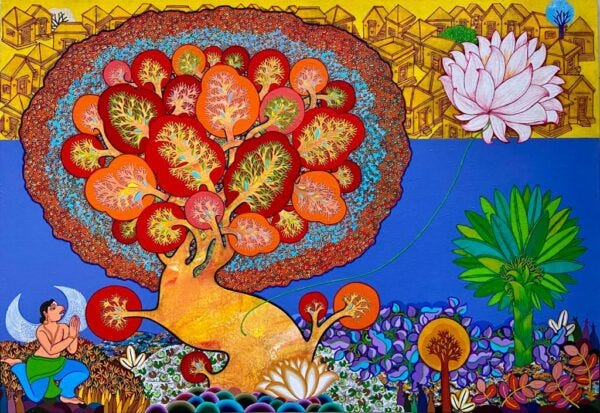Coconuts
A complex food, filled with problem and potential. Featuring a tomato-coconut soup!
Here’s a recipe that’s both tropical and transitional for those living in non-tropical climates: a tomato-coconut soup. Summery ingredients in a fall format.
I made a version of this soup earlier this summer, when one of my fellow gardeners gifted me with a bunch of small orange tomatoes (sungolds) from her bed.
I mashed them up that same evening in a pot, along with a can of coconut milk basil, garlic and hot peppers. It ended up being so easy and delicious that this soup will now be a regular part of my rotation, especially because the combination of tomatoes and coconuts can be used in different flavor profiles from around the world.
Here's a Desi-style version:
Desi-style tomato-coconut soup
A silky soup, with the flavors of the land where the people's skin is the color of bourbon.
Ingredients:
Tomatoes, oil (any - I used olive), onion, hot peppers, coconut milk, mustard seed, cumin, garam masala, salt
Instructions:
Blooming the spices at the first step should take a minute or two — you want to sense bursting, browning, sizzling, all that good stuff.
This is my first continuous motion video! I’m a stop-motion video pro 😎 — here’s one I made of mint-cilantro chutney and another on rye fig newtons. The big issue is the steam -- how do food video makers eliminate the steam in their cooking videos? If you have any tips, let me know in the comments or at shreema@climatecookery.com!
Whiz it through a food processor -- or you know, don’t. It’ll be tasty either way, IMHO.
A word about 🥥:
Coconuts are an iconic example of why we need agrobiodiversity. Why we must move away from hyper-efficiency, high-slope economies of scale, moving fast and breaking things, in the way we grow and eat food.

Coconuts are abundant and non-fussy. Each and every portion of the plant is useful — no food waste here. In South Asian countries, I learned that their trees are referred to as kalpavriksha, a divine, wish-fulfilling tree in Hindu, Buddhist and Jain mythology, because they’re useful and bountiful (and delicious!)
Coconut plantations, in which land is bulldozed to grow lots of coconuts and just coconuts, seem to eliminate or reduce many of these benefits. Growing a single crop on huge tracts of land achieves (short-term) economic gains, but it depletes the soil, causes erosion, necessitates the use of more pesticides and water to sustain an unnatural system — I can go on (and I will in a future newsletter!) And they keep people in colonial poverty.
My mission in Climate Cookery is to celebrate underutilized, climate-smart crops overlooked by the industrial food system that diversify farms, stores, diets. Coconuts can be climate-smart, but they’re certainly not underutilized - especially not in the past 10 years or so, when products like coconut oil and coconut water started becoming trendy.
See if this sounds familiar to you:
Rich people in rich countries "discover" a food.
This food, already widely used locally, soars in global popularity.
There's a mad rush to commercialize this food, which hurts the environment and the people living in these environments.
The liberal versions of the rich people in the rich countries start feeling guilty and write think pieces (guilt pieces?) about how actuallllllly....this food is bad and we shouldn't eat it anymore.
In the blink of an eye, a neutral food with a critical role in many storied, complex cuisines goes through a rotation of labels: neutral/no-label —> good —>bad.
This above scenario is something I wrestled when I was selling Kick+Tang, my tamarind hot sauce. Like, I don’t want to be this f’in guy. I have the humility to understand it’s unlikely I would have been/would be. But also…I don’t want to be this f’in guy.
But I don’t think the solution is to not eat coconuts (or other foods from far away, like tamarind), or at least I don’t want it to be. A big part of being human is reshaping your culture after you experience something new from a different culture. Life would be boring without this phenomenon.
I think the solution lies in moving away from monocropped plantations (and I’m not just talking about tropical countries, I’m very much talking about farmland in the US, too) and toward smaller, diverse systems that deploy intercropping or agroforestry — that mix it up.
I’ll explore these diversification opportunities in a future newsletter and why they’re important — stay tuned!
Li’l nub:
Hanumankind
Holy shit. This music video and Hanumankind’s catalogue has left me shook, transported, all of it.
Could India be the next South Korea, in the sense of unleashing fascinating, exciting, sexy new perspectives on Western culture that resonate with a global audience? I’m gonna say yes!
I’d love your quick feedback before we part ways:







